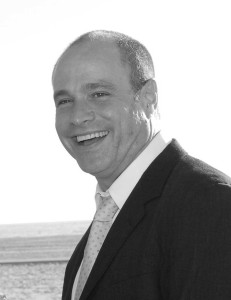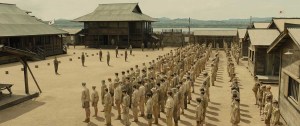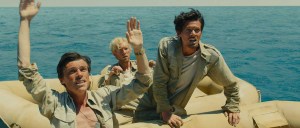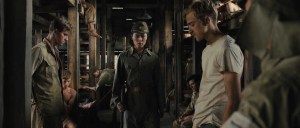
For production designer Jon Hutman, the heart of director Angelina Jolie’s film Unbroken are the three successive and visually diverse POW camps that punctuate former Olympian Louis “Louie” Zamperini (Jack O’Connell)’s epic journey of resilience and survival during World War II.
The scale of the sets Hutman designed on location in Australia were enormous and detailed to a fault, from the vast dusty stretches of the Omori prison camp to the interior of the B-24 bomber seen at the start of the movie—much of it assembled from collectors, museums and replica aficionados. Omori, the main prison camp where Louie meets the sadistic “Bird,” is the only purpose-built camp in the film said Hutman, constructed outside Brisbane in Fort Lytton National Park from scratch on a single dirt patch. “There were a lot of historical references of these camps taken at the end of the war,” said Hutman, who designed Jolie’s first effort as a writer/director, In the Land of Blood and Honey. “We added a little bit more of a Japanese architectural detail. It’s subtle but I think it’s effective. In the book, Laura Hillenbrand says Omori was like being on the surface of the moon. And one of Angie’s initial visual concepts for Omori was this kind of dusty monochromatic quality. You have the dust, the wood and the uniforms are this single, desaturated value.”
The sheer size of Omori, added set decorator Lisa Thompson, was overwhelming. “You felt that as you walked among it. That sense of being exposed to the elements was very real.” Thompson’s range of credits include HBO‘s WWII mini-series The Pacific, as well as Where the Wild Things Are, Moulin Rouge and Romper Stomper.

The concept for the first of Zamperini’s POW camps, the Marshall Island Kwajalein, was tropical and South Pacific. “We kind of took it a step further by finding this location in a rain forest in Australia,” said Hutman. “It felt sort of Cambodian to both Angie and myself, so we were trying to conjure these ruins in the jungle. What you feel when you are with Louie is you are in one of the strangest, most exotic place that you can imagine, a huge contrast to 47 days in the open sea in a raft. It’s all about claustrophobia.”
Hutman and Jolie first met in Venice on the opulent thriller The Tourist and have just finished making Jolie’s third film, By the Sea, in which she also stars opposite husband Brad Pitt. “When Angie was first contemplating doing Unbroken, she knew she’d never done anything like it before,” said Hutman. “I said, ‘Look: when you hired me to do Blood and Honey, I had never done anything like that before, so sometimes you have to take a leap. She told me, ‘I wanted that movie to be beautiful and I knew you would make it beautiful.’ That sentiment is underneath what we’ve done ever since: finding the sublime beauty in the horrific experience and vice versa. That’s what is so complex and compelling about Angie as a filmmaker is that sensibility. She always has had that vision, out of the gates.”
 “What I did when I came in to this picture—which is what I always do—is add that additional visual idea that comes directly out of the narrative,” he said. “I feel like my job as the production designer is to get inside the head of the director and take the audience an extra step, so that the film looks the way it feels to the protagonist. This is an idea that came from Angie that we expanded on. I used to think that my job was to show up at the interview with the movie designed, but it is clearly to take the germs of their ideas they have, and develop them. As we make choices, it’s also my job to make sure the pieces of the entire puzzle fit together into a coherent whole. What I’m most proud of in this film is the way all of those pieces fit together.”
“What I did when I came in to this picture—which is what I always do—is add that additional visual idea that comes directly out of the narrative,” he said. “I feel like my job as the production designer is to get inside the head of the director and take the audience an extra step, so that the film looks the way it feels to the protagonist. This is an idea that came from Angie that we expanded on. I used to think that my job was to show up at the interview with the movie designed, but it is clearly to take the germs of their ideas they have, and develop them. As we make choices, it’s also my job to make sure the pieces of the entire puzzle fit together into a coherent whole. What I’m most proud of in this film is the way all of those pieces fit together.”
Hutman said Naoetsu, the final POW setting that closes the film, had to feel like the very last outpost at the end of the world. “It’s described in the book as being this industrial fishing village and port and the camp itself was built in an abandoned salt factory on these cliffs overlooking this port. This place was one of the locations that drew us ultimately to film in Australia: Cockatoo Island, a Naval shipyard in the middle of Sydney Harbor. Angie’s whole idea for this section of the film was that this sequence should be about black and white. These men covered with coal but everything else was cold and snowy and white.”
 Sprinkled throughout the bleak stretch of isolation are glimpses of civilization. “Before Louie and Phil are transferred from Kwajalein to Tokyo, before they get to Omori, they arrive at Yokahama Port, which we mainly see through the brief glimpses Louie gets from inside his blindfold. The color and new cars gives him this moment of hope that he is returning to civilization for good. The second beat of that scene is the Radio Tokyo scene, when he is taken to lunch and put on the air.” An abandoned office building “with amazing bones” was given a spiff and polish and a lush, stylized painted wave mural along the wall. “The shiny floors, shiny tables and mural were all meant to be clean with slightly exaggerated sour colors, kind of like the food: so unfamiliar and tempting and delicious, but a little strange.”
Sprinkled throughout the bleak stretch of isolation are glimpses of civilization. “Before Louie and Phil are transferred from Kwajalein to Tokyo, before they get to Omori, they arrive at Yokahama Port, which we mainly see through the brief glimpses Louie gets from inside his blindfold. The color and new cars gives him this moment of hope that he is returning to civilization for good. The second beat of that scene is the Radio Tokyo scene, when he is taken to lunch and put on the air.” An abandoned office building “with amazing bones” was given a spiff and polish and a lush, stylized painted wave mural along the wall. “The shiny floors, shiny tables and mural were all meant to be clean with slightly exaggerated sour colors, kind of like the food: so unfamiliar and tempting and delicious, but a little strange.”
The flip side of the glamorous Yokohama scenes, said Hutman, were the film’s final images of bombed Tokyo. “Angie and I had a lot of war-torn scenes in our first film together, but let’s be honest: I worked with Nancy Meyers for 10 years. I was the guy who does fancy houses,” including the elegant, artisanal kitchens featured in Something’s Gotta Give and It’s Complicated. “But we had this vocabulary of what post-bomb Tokyo would feel like going in. We found a location that was in the middle of downtown Sydney that was a full city block slated for demolition. We used the back sides of the building and we built the other side of the street. We were also deeply inspired by the artist Maurizio Cattelan, whose marble sculpture of dead bodies covered in sheets we’d both been very moved by in Venice while working on The Tourist.”
“Jon is just the most energetic, dynamic designer and came to the party with this incredible vision, which began with Angelina Jolie, of having it all rendered as honestly and realistically as possible,” added Thompson. “They wanted the actors living in a real world.”





